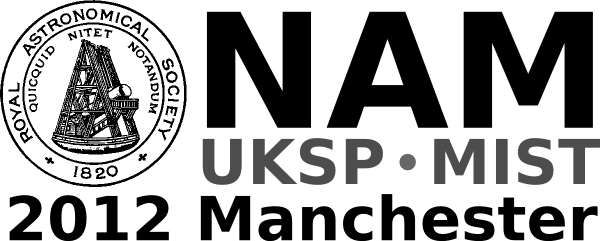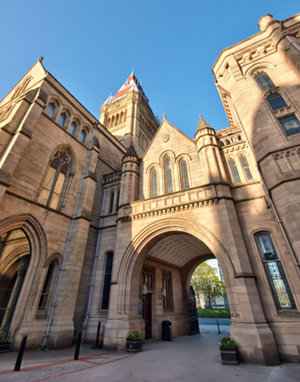UK-Germany National Astronomy Meeting NAM2012
Evidence stacks up that monolith at Gardom's Edge is astronomically aligned
Royal Astronomical Society press release
RAS PR 12/13 (NAM 04)
Tuesday 27 March 2012
Researchers at the Nottingham Trent University have gathered new evidence that a 4000-year-old monolith was aligned to be an astronomical marker. The 2.2 metre high monument, located in the Peak District National Park, has a striking, right-angled triangular shape that slants up towards geographic south. The orientation and inclination of the slope is aligned to the altitude of the Sun at mid-summer. The researchers believe that the monolith was set in place to give symbolic meaning to the location through the changing seasonal illuminations. Dr Daniel Brown will present the findings on Tuesday 27th March at the National Astronomy Meeting in Manchester.
The rare example of a monolith is located at Gardom's Edge, a striking millstone grit ridge less than an hour's drive from Manchester. The researchers have carried out a microtopography survey of the surface surrounding the monolith. Their findings indicate the presence of packing stones around the base of the monolith, evidence that it was placed carefully in position. They have also carried out 3-D modelling of illumination of the stone through the seasons, adapting for changes in the Earth's tilt to the ecliptic plane over four millennia.
The landscape surrounding the stone harbours many ancient monuments such as Bronze Age roundhouses, a late Neolithic enclosure, and other traces of a long lasting human occupation. The researchers believe that the stone is also late Neolithic, set in place around 2000 BC.
"Given the sensitivity of the site, we can't probe under the surface of the soil. However, through our survey, we have found a higher density of packing stones on one side, supporting the case that the stone has been orientated intentionally," said Dr Brown.
The 3-D modelling shows that during the winter half-year, the slanted side of the stone would remain in permanent shadow; during most of the summer half-year it would only be illuminated during the morning and afternoon; close to midsummer it would be illuminated all day. The researchers are currently backing up the modelling work by gathering contemporary photographic evidence of the stone.
"The stone would have been an ideal marker for a social arena for seasonal gatherings," said Dr Brown. "It's not a sundial in the sense that people would have used it to determine an exact time. We think that it was set in position to give a symbolic meaning to its location, a bit like the way that some religious buildings are aligned in a specific direction for symbolic reasons."
The researchers hope that the new evidence will support the case for a wider archaeological survey of the site.
"The use of shadow casting in monuments of this period is quite rare in the British Isles," said Dr Brown. "But there are some examples including New Grange, Ireland, and some Clava cairns in the north-east of Scotland that have been proposed to include the intentional use of shadows. Both are associated to burial sites using the symbolism of a cyclic light and shadow display to represent eternity. Given the proximity of the Neolithic enclosure and possible ritual importance of this site, the Gardom's Edge monolith could be another such example."
IMAGES
Images can be found at: http://danielbrown.pbworks.com/w/page/27407022/Links
- Gardom Monolith: Image from the team's photographic survey (Oct 2011), taken looking directly to the west. Note the triangular shape and flat north facing side. Credit: D Brown/Nottingham Trent University. http://danielbrown.pbworks.com/w/file/52152137/GardomMonolithViewToEast.JPG
- Standing Stone Model: Illustration of the stone looking to the south-east in a moment in time (Summer half of the year 2000 BC) just after the north-facing side sees Sunlight for the first time after a brief spell of darkness during midday. The periods of darkness at midday will slowly decrease until around Midsummer when the north-facing side is illuminated during midday as well. Credit: D Brown/Nottingham Trent University. http://danielbrown.pbworks.com/w/file/52152135/Standing%20Stone%20Model%20V2_2000BC_May31_14UT.tif
- Monolith Profiles: This sketch gives an overview of the different profiles of the standing stone as they appear when viewing either to the north, east, south or west. Credit: D Brown/Nottingham Trent University. http://danielbrown.pbworks.com/w/file/52152107/Standing%20Stone%20Sketch.tif
- Gardom Monolith: View towards the south. This image shows how the north-facing side remains in shadow in the winter half year even during midday. Credit: D Brown/Nottingham Trent University. http://danielbrown.pbworks.com/w/file/52152111/MidDay13Oct.jpg
- Microtopology: This contour map indicates the possible location of packing stones and their increase density towards the NW base of the Monolith. Credit: D Brown/Nottingham Trent University. http://danielbrown.pbworks.com/w/file/52152086/micro%20topology%20base%20stone%20Figure.tiff
MEDIA CONTACTS
NAM 2012 Press Office (0900 - 1730 BST, 27-29 March; 0900 - 1630 BST 30 March)
Room 3.214
University Place building
University of Manchester
Manchester
UK
Tel: +44 (0)161 306 7313
Dr Robert Massey
Royal Astronomical Society
Mob: +44 (0)794 124 8035
Email: rm@ras.org.uk
Anita Heward
Royal Astronomical Society
Mob: +44 (0)7756 034 243
Email: anitaheward@btinternet.com
Dr Klaus Jaeger
Pressereferent / Press Officer im Vorstand der Astronomischen Gesellschaft
Tel: +49 6221 528 379
Email: pressereferent@astronomische-gesellschaft.de
Dan Cochlin
Media Officer (Faculty of Engineering and Physical Sciences)
University of Manchester
Tel: +44 (0)161 275 8387
Email: daniel.cochlin@manchester.ac.uk
SCIENCE CONTACTS
Dr. Daniel Brown
Physics and Mathematical Sciences
School of Science & Technology
Nottingham Trent University
Tel: 0115 848 3518
Email: daniel.brown02@ntu.ac.uk
On Tuesday 27 and Wednesday 28 March, Dr Brown can be contacted through the NAM 2012 Press Office
NOTES FOR EDITORS
Standing Stone at Gardom's Edge
The overall project website for the 3-D survey: http://archaeopoject.pbworks.com/w/page/30712199/Standing%20Stone%20Gardom%27s%20Edge
NAM 2012
Bringing together more than 900 astronomers and space scientists, the National Astronomy Meeting (NAM 2012) will take place from 27-30 March 2012 in the University Place conference centre at the University of Manchester in the UK. The conference is a joint meeting of the Royal Astronomical Society (RAS) and the German Astronomische Gesellschaft (AG) and is held in conjunction with the UK Solar Physics (UKSP: www.uksolphys.org) and Magnetosphere Ionosphere Solar Terrestrial (MIST: www.mist.ac.uk) meetings. NAM 2012 is principally sponsored by the RAS, AG, STFC and the University of Manchester.
The Royal Astronomical Society
The Royal Astronomical Society (RAS: www.ras.org.uk), founded in 1820, encourages and promotes the study of astronomy, solar-system science, geophysics and closely related branches of science. The RAS organises scientific meetings, publishes international research and review journals, recognizes outstanding achievements by the award of medals and prizes, maintains an extensive library, supports education through grants and outreach activities and represents UK astronomy nationally and internationally. Its more than 3500 members (Fellows), a third based overseas, include scientific researchers in universities, observatories and laboratories as well as historians of astronomy and others.
The Astronomische Gesellschaft (AG)
The Astronomische Gesellschaft (AG: www.astronomische-gesellschaft.de), founded in 1863, is a modern astronomical society with more than 800 members dedicated to the advancement of astronomy and astrophysics and the networking between astronomers. It represents German astronomers, organises scientific meetings, publishes journals, offers grants, recognises outstanding work through awards and places a high priority on the support of talented young scientists, public outreach and astronomy education in schools.
The Science and Technology Facilities Council
The Science and Technology Facilities Council (STFC: www.stfc.ac.uk) is keeping the UK at the forefront of international science and tackling some of the most significant challenges facing society such as meeting our future energy needs, monitoring and understanding climate change, and global security. The Council has a broad science portfolio and works with the academic and industrial communities to share its expertise in materials science, space and ground-based astronomy technologies, laser science, microelectronics, wafer scale manufacturing, particle and nuclear physics, alternative energy production, radio communications and radar. It enables UK researchers to access leading international science facilities for example in the area of astronomy, the European Southern Observatory.
Jodrell Bank Centre for Astrophysics
The Jodrell Bank Centre for Astrophysics (JBCA: www.jb.man.ac.uk) is part of the School of Physics & Astronomy at the University of Manchester. JBCA is split over two main sites: the Alan Turing Building in Manchester and the Jodrell Bank Observatory in Cheshire. At Jodrell Bank Observatory, the new Jodrell Bank Discovery Centre is a key focus for our work in public engagement and education. Jodrell Bank is a world leader in radio astronomy-related research and technology development with a research programme extending across much of modern astrophysics. The group operates the e-MERLIN national radio astronomy facility and the iconic Lovell Telescope, hosts the UK ALMA Regional Centre Node and is home to the international office of the SKA Organisation. Funded by the University, the Science & Technology Facilities Council and the European Commission, it is one of the UK's largest astrophysics research groups.





